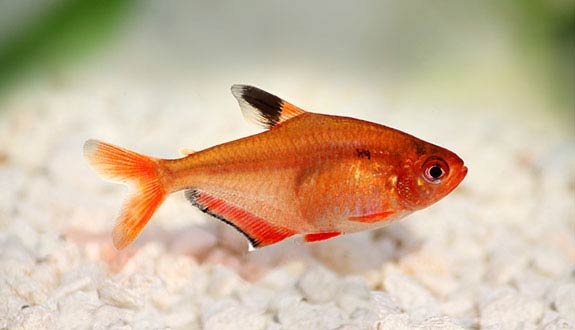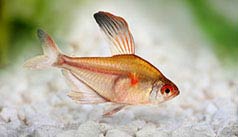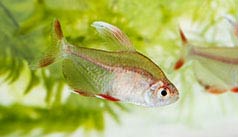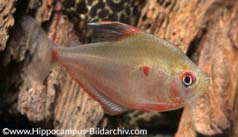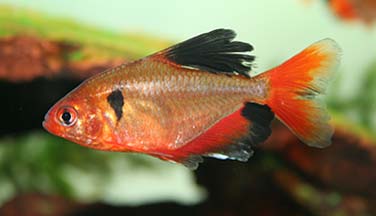

Alternative species (click on the thumbnail to see the card)
Names
Scientific name
Hyphessobrycon eques
Chirodon eques
Hyphessobrycon callistus
Hyphessobrycon serpae
Tetragonopterus callistus
Common name
Serpae tetra
Jewel tetra
Callistus tetra
Red Minor Serpae Tetra
Origin

Origin: Paraguay, Bolivia
Biotope: Amazonian
Dimorphism

The male is more slender than the female and has a more intense red colour. Its caudal fin is entirely black, while the female's has a white patch on its tail.
Group

Characidae
Volume

100 L / 22 Imp Gal / 26 US Gal
Parameters

T°: 23 to 28°C or 3 to 82°F
pH: 6.8 to 7.2
Hardness: 10 to 15°dGH
Difficulty

Average
Size

4cm (1.6")
Longevity

2 to 4 years
Living zone
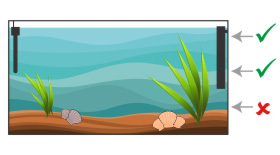
Middle and top
Individuals

10
Food
How to feed the Serpae tetra?
Food
How to feed the Serpae tetra?
You should have no problem feeding this omnivorous fish. It accepts all types of food. However, there is a clear preference for live prey such as artemia, bloodworms, mosquito and insect larvae. The distribution of live food soothes its quarrelsome temperament. Freeze-dried food such as flakes or pellets can be used as supplementary food.
Behavior
What kind of behavior does the Serpae tetra have?
Behavior
What kind of behavior does the Serpae tetra have?
Like all grouse, these fish have a gregarious instinct and will enjoy living in schools. It will take a group of at least 10 individuals to make the capercaillie feel comfortable. Note that a fish alone or in a group that is too small develops a certain aggressiveness towards its roommates. For example, it may chew on the fins of its roommates. In fact, it is a symptom of a lack of social interaction within its species. If you encounter this situation, give your fish some of your own!
Generally speaking, they are moderately aggressive both in their interspecific relationships and with other species. Let's say they tend to be quarrelsome at times. This is especially true for males, who are quite teasing each other. Also, when distributing food, they may heckle each other. You have to make sure that everyone eats well and that this aggressiveness is not too excessive.
Cohabitation
Who can live with the Serpae tetra?
Cohabitation
Who can live with the Serpae tetra?
Pacific and sociable, the tetra jewel will be able to accommodate life in a community aquarium. You can easily associate it with other members of the Characidae family with an active temperament. It will also associate harmoniously with the Apistogramma.
Avoid association with species with large fins such as Betta or Guppy.
Breeding
How to breed the Serpae tetra?
Breeding
How to breed the Serpae tetra?
The reproduction of the Serpae is quite difficult.
Prepare a breeding aquarium of about 30 liters including a carpet of Java moss, pebbles and a small filter with an enhancer. Dim the lighting with floating plants. Recommended water parameters for breeding are water at 25°C, pH 6.5/7 and hardness 10°dGH. Add oak leaves or alder fruit to sieve the water.
Isolate a couple you have selected in a breeding aquarium (choose a female with a well rounded belly). Feed them abundant live prey. After a short period of adaptation, the male will court the female and eventually lay eggs. The female releases the eggs which the male fertilizes immediately. The eggs are small and greyish. Once oviposition is complete, remove the parents and plunge the breeding aquarium into the dark, make it opaque. This is because the eggs are lucifugal, which means they are afraid of light. Incubation lasts 24/48 hours.
Spruce grouse are quite prolific and gregarious. The young fish are shy and sometimes they attack each other, even tearing their fins. You can partly limit this aggression by giving them more live food. As they grow, gently bring the light back into the aquarium.
Fry food: infusers, rotifers. After 1 week or more, nauplia of artemia or cyclops.
Its aquarium
Which aquarium for the Serpae tetra?
Its aquarium
Which aquarium for the Serpae tetra?
It lives naturally in water with low current and cluttered with branches and roots. Its environment is therefore calm and fairly shady.
To reproduce these conditions in captivity, do not make too much current in your aquarium. Your decor will consist mainly of peat bog roots and branches. Plant densely around these elements and don't forget the floating plants that will dim the lighting.
Good To know
Find all additional information!
Good To know
Find all additional information!
Because of the many hybridizations within their group, the identification and recognition of species around Callisutus are a bit difficult. The species belonging to this group are:
Hyphessobrycon callistus
Hyphessobrycon serpae
Hyphessobrycon minor
Hyphessobrycon hasemani
Hyphessobrycon haraldschultzi
Hyphessobrycon georgettae (rare in aquaristics)
Hyphessobrycon takasei (rare in aquaristics)
There are "balloon" and long-finned varieties from successive selections. These fish are often much more fragile than the basic species, and their quality of life is not very satisfactory because of the malformations they encourage. We can only encourage you to avoid this kind of specimen.
Robust, easy to acclimatise and tolerant to water parameters, this tetra can be offered to beginner aquarists without any problem.
Yours photos!
Comments
Sort by:
Please login to post comments
